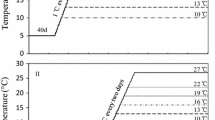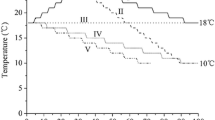Abstract
Asexual reproduction of polyps of Nemopilema nomurai, of which massive blooms have occurred in Korean waters every summer since 2003, were tested under 20 combinations of temperature (10, 15, 20, and 25°C) and salinity (12, 17, 22, 27, and 32 psu). Production of podocysts increased with increasing temperature (20 and 25°C), while strobilaton and ephyral liberation occurred at low temperatures (10 and 15°C). Temperature also affected the initiation of ephyral liberation (approximately 25 days at 15°C, and 50 days at 10 and 20°C, respectively). The number of podocysts was only significantly different between 27 and 32 psu, and salinity had no significant effect on the excystment of podocysts, ephyral liberlation, showing N. nomurai is euryhaline. These results demonstrated that temperature is an important factor on both the podocysts production and ephyrae liberation, possibly explaining early spring liberation of ephyrae and continuous introduction of medusae into Korean coastal waters through summer to fall.
Similar content being viewed by others
References
Arai MN (2009) The potential importance of podocysts to the formation of scyphozoan blooms: a review. Hydrobiologia 616: 241–246
Brewer RH, Feingold JS (1991) The effect of temperature on the benthic stages of Cyanea (Cnidaria: Scyphozoa), and their seasonal distribution in the Niantic River estuary, Connecticut. J Exp Mar Biol Ecol 152: 49–60
Cargo DG, Schultz LP (1967) Further observations on the biology of the sea nettle and jellyfishes in Chesapeake Bay. Chesapeake Sci 8: 209–220
Cargo DG (1974) Comments on the laboratory culture of Scyphozoa. In: Smith WL, Chanley M (eds) Culture of marine invertebrate animals. Plenum, New York, pp 145–154
Coyne JA (1973) An investigation of the dynamics of population growth and control in scyphistomae of the scyphozoan Aurelia aurita. Chesapeake Sci 14: 55–58
Custance D (1964) Light as an inhibitor of strobilation in Aurelia aurita. Nature 204: 1219–1220
Dong Z, Liu D, Keesing JK (2010) Jellyfish blooms in China: dominant species, cause and consequences. Mar Pollut Bull 60: 954–963
Dong J, Sun M, Purcell JE, Chai Y, Zhao Y, Wang A (2015) Effect of salinity and light intensity on somatic growth and podocyst production in polyps of the giant jellyfish Nemopilema nomurai (Scyphozoa: Rhizostomeae). Hydrobiologia 754: 75–83
Feng S, Zhang F, Sun S, Wang S, Li C (2015a) Effects of duration at low temperature on asexual reproduction in polyps of the scyphozoan Nemopilema nomurai (Scyphozoa: Rhizostomeae). Hydrobiologia 754: 97–111
Feng S, Zhang G, Sun S, Zhang F, Wang S, Liu M (2015b) Effects of temperature regime and food supply on asexual reproduction in Cyanea nozakii and Nemopilema nomurai. Hydrobiologia 754: 201–214
Hernroth L, Gröndahl F (1985) On the biology of Aurelia aurita (L.): 3. Predation by Coryphella verrucosa (Gastropoda, Opisthobranchia), a major factor regulating the development of Aurelia populations in the Gullmar fjord, western Sweden. Ophelia 24: 37–45
Hofmann DK, Neumann R, Henne K (1978) Strobilation, budding and initiation of scyphistoma morphogenesis in the rhizostome Cassiopea andromeda (Cnidaria: Scyphozoa). Mar Biol 47: 161–176
Ishii H, Watanabe T (2003) Experimental study of growth and asexual reproduction in Aurelia aurita polyps. Sessile Organisms 20: 69–73
Kakinuma Y (1975) An experimental study of the life cycle and organ differentiation of Aurelia aurita Lamarck. Bull Mar Biol Sta Asamushi 15: 101–113
Kawahara M, Uye S, Ohtsu K, Iizumi H (2006) Unusual population explosion of the giant jellyfish Nemopilema nomurai (Scyphozoa: Rhizostomeae) in East Asian waters. Mar Ecol-Prog Ser 307: 161–173
Kawahara M, Ohtsu K, Uye S (2013) Bloom or non-bloom in the giant jellyfish Nemopilema nomurai (Scyphozoa: Rhizostomeae): roles of dormant podocysts. J Plankton Res 35: 213–217
Keen S, Gong A (1989) Genotype and feeding frequency affect clone formation in a marine cnidarian (Aurelia aurita Lamark 1816). Funct Ecol 3: 735–745
Keen S (1991) Clonal dynamics and life history evolution in the jellyfish Aurelia aurita. Ph.D. Thesis, University of California, 183 p
Liu WC, Lo WT, Purcell JE, Chang HH (2009) Effects of temperature and light intensity on asexual reproduction of the scyphozoan, Aurelia aurita (L.) in Taiwan. Hydrobiologia 616: 247–258
Loeb MJ (1972) Strobilation in the Chesapeake Bay sea nettle Chrysaora quinquecirrha: 1. The effects of environmental temperature changes on strobilation and growth. J Exp Zool 180: 279–292
Lu N, Liu C, Guo P (1989) Effect of salinity on larva of edible medusae (Rhopilema esculenta Kishinouye) at different developmental phases and a review on the cause of jellyfish resources falling greatly in Liaodong Bay. Acta Ecol Sin 9: 304–309 (in Chinese)
Lu N, Jiang S, Chen J (1997) Effect of temperature, salinity and light on the podocyst generation of Rhopilema esculenta Kishnouye. Fish Sci 16: 3–8 (in Chinese)
Ma X, Purcell JE (2005) Temperature, salinity and prey effects on polyp versus medusa bud production of the invasive hydrozoan, Moerisia lyonsi. Mar Biol 147: 225–234
Purcell JE (2007) Environmental effects on asexual reproduction rates of the scyphozoan, Aurelia labiata. Mar Ecol-Prog Ser 348: 183–196
Purcell JE, Båmstedt U, Båmsted A (1999a) Prey, feeding rates, and asexual reproduction rates of the introduced oligohaline hydrozoan Moerisia lyonsi. Mar Biol 134: 317–325
Pucell JE, White JR, Nemazie DA, Wright DA (1999b) Temperature, salinity and food effects on asexual reproduction and abundance of the scyphozoan Chrysaora quinquecirrha. Mar Ecol-Prog Ser 180: 187–196
Silverstone M, Tosteson T, Cutress C (1977) The effect of iodine and various iodocompounds on initiation of strobilation in Aurelia. Gen Comp Endocr 32: 108–113
Spangenberg DB (1964a) A study of strobilation in Aurelia aurita under controlled conditions. J Exp Zool 160: 1–10
Spangenberg DB (1964b) New observations on Aurelia. T Am Microsc Soc 83: 448–455
Spangenberg DB (1967) Iodine induction of metamorphosis in Aurelia. J Exp Zool 165: 441–449
Spangenberg DB (1968) Recent studies of strobilation in jellyfish. Oceanogr Mar Biol 6: 231–247
Sun M, Dong J, Purcell JE, Li Y, Duan Y, Wang A, Wang B (2014) Testing the influence of previous-year temperature and food supply on development of Nemopilema nomurai blooms. Hydrobiologia 754: 85–96
Sun S, Zhang F, Li C, Wang S, Wang M, Tao Z, Wang Y, Zhang G, Sun X (2015) Breeding places, population dynamics and distribution of the giant jellyfish Nemopilema nomurai (Scyphozoa: Rhizostomeae) in the Yellow Sea and the East China Sea. Hydrobiologia 754: 59–74
Toyokawa M, Shibata M, Cheng JH, Li HY, Ling JJ, Lin N, Liu ZL, Zhang Y, Shimizu M, Akiyama H (2012) First record of wild ephyrae of the giant jellyfish Nemopilema nomurai. Fish Sci 78: 1213–1218
Uye S (2008) Blooms of the giant jellyfish Nemopilema nomurai: a threat to the fisheries sustainability of the East Asian Marginal Seas. Plankton Benthos Res 3: 125–131
Wang B, Qin Y, Dong J, Li Y, Wang W, Li Y, Sun M, Liu C (2013) Dynamic distribution of Nemopilema nomurai in inshore waters of the northern Liaodong Bay, Bohai Sea. Acta Ecol Sin 33: 1701–1712 (in Chinese)
Willcox S, Moltschaniwskyj NA, Crawford C (2007) Asexual reproduction in scyphistomae of Aurelia sp.: Effects of temperature and salinity in an experimental study. J Exp Mar Biol Ecol 353: 107–114
Yoon WD, Lee HE, Han CH, Chang SJ, Lee KH (2014) Abundance and distribution of Nemopilema nomurai (Scyphozoa, Rhizostomeae) in Korean waters in 2005–2013. Ocean Sci J 49(3): 183–192
Zhang HY, Zhao L, Wei H (2012) Origin of the giant jellyfish in Qingdao offshore in summer. Oceanol Limnol Sin 43: 662–663
Author information
Authors and Affiliations
Corresponding author
Rights and permissions
About this article
Cite this article
Lee, H.E., Han, C.H., Kim, B. et al. Effects of temperature and salinity on the asexual reproduction of Nemopilema nomurai (Scyphozoa: Rhizostomeae). Ocean Sci. J. 52, 573–579 (2017). https://doi.org/10.1007/s12601-017-0040-5
Received:
Revised:
Accepted:
Published:
Issue Date:
DOI: https://doi.org/10.1007/s12601-017-0040-5




